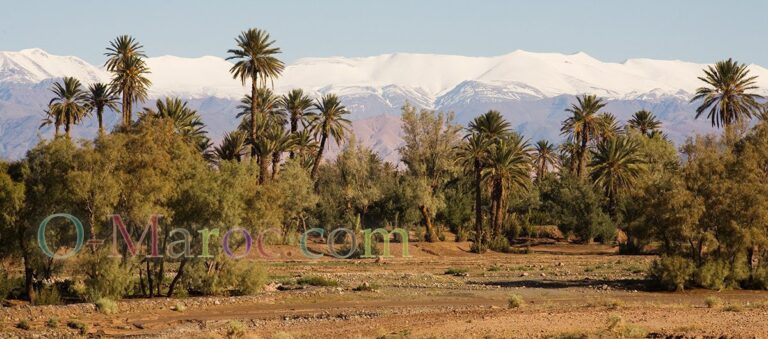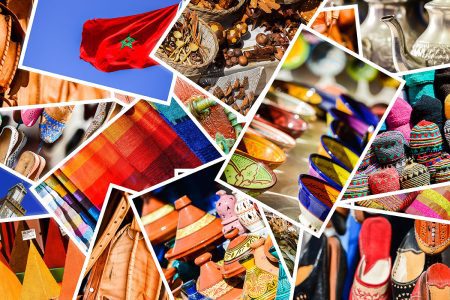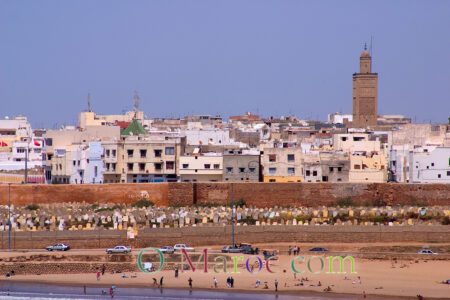The palm tree and the snow
Lyautey said that Morocco is a cold country where the sun is hot.
This is indeed the land of extremes, one of the few countries where you can see palm trees against a backdrop of snow, the peaks of the ‘High-Atlas’ being so close to the first ‘deserts’.
This is the land of drought and heavy rains, of rivers that have dried up for years and then suddenly burst with rain, flooding their valleys. This is the land where you can see snow falling on sand dunes, and pink flamingos landing in lakes at the foot of those same dunes.
Criss-crossed by mountains, the highest of which, the ‘Toubkal’, rises to 4,167 m, divided between deserts and fertile plains, Morocco experiences irregular rainfall, which can be violent but is generally rare. The country often fears drought, although rainfall has been more abundant in recent years.
The coastal strip has a generally mild climate, but winters are wet and can be cold in the north. In ‘Casablanca’, temperatures range from 8-10°C in winter to 25-26°C in summer, in ‘Agadir’ from 14°C on average in winter to 25°C in summer. In ‘Essaouira’, a surfer’s paradise, a strong wind sweeps through the town all year round, and it can be colder in summer than in winter. As you head further south, towards ‘Laayoune’, the temperatures rise, reaching an average of 30°.
The Mediterranean coast is pleasant from May to October. In ‘El, winter temperatures do not exceed 15°C. But as soon as you reach the ‘Rif massif, winter can be freezing, with temperatures as low as -10°/-20°, and heavy snow.
The same applies in the ‘Middle’and the ‘Anti-Atlas’. It is not uncommon for the mercury to drop below 0° during the day in ‘Ouarzazate’.
The imperial cities, which are pleasant all year round, can be very hot in summer. In ‘Marrakesh’, average summer temperatures can easily reach 30°C, but in winter you can enjoy your coffee on the terrace in a T-shirt.
In the far south, and on the borders of the desert, temperatures soar in summer to 40°C, or even 50°C in full sun.
In winter, the days are pleasant but the nights can be freezing. The difference between day and night is considerable, whether in the desert, deep in the gorges or in the mountainous regions, and the temperature range can easily reach 30°. Spring and summer are the seasons of the hot winds, or cherguis.
(This post was first published on the now defunct Mezgarne website).
Global warming: the impact on Morocco
COP 22, held in Marrakesh at the end of last year, raised Moroccans’ awareness of the challenges posed by climate change.
We can already see the consequences in Morocco, with maximum temperatures rising during the summer (up to 48-50 in the south, which used to be exceptional), longer summers, less snow, less rain, but more violent when it comes.
Above all, it is difficult to estimate what will actually happen in Morocco: some say it will turn into a furnace, while others believe that the climate in the north of the country will become similar to that in Brittany today.
What will happen to the crops on the Sous plain? Will there be as many tourists in an extremely hot country? And politically, will Morocco be able to withstand the migratory pressure from countries already undergoing desertification?
Cold winters, oh yes
As I reread this post to republish it, I remember how cold I could have been some winters, in Ouarzazate in particular.

I remember snow-covered mountain passes and, off the main roads, villages isolated for days at a time, people freezing to death…
It’s going to be cold again this winter – the snow has already fallen in Chefchaouen!

 A typo or syntax error? You can select the text and hit Ctrl+Enter to send us a message. Thank you! If this post interested you, maybe you can also leave a comment. We'd love to exchange with you !
A typo or syntax error? You can select the text and hit Ctrl+Enter to send us a message. Thank you! If this post interested you, maybe you can also leave a comment. We'd love to exchange with you !




